CHCECE001 Assessment: Analyzing Cultural Diversity and Responsiveness
VerifiedAdded on 2023/06/18
|6
|922
|115
Homework Assignment
AI Summary
This CHCECE001 assignment delves into the multifaceted aspects of cultural diversity within early childhood education. It addresses the impact of cultural beliefs on individuals, the challenges posed by diverse backgrounds in communication, and strategies for fostering cultural competence. The assignment explores reciprocal relationships, collaboration with childcare organizations, and representation of various cultural groups, including European and Chinese ethnicities. It emphasizes the importance of sharing information appropriately and tailoring support to meet specific needs. Furthermore, the assignment examines the celebration of Australia Day as a means of promoting collaboration and problem-solving, while also considering the historical context and contemporary impacts on Aboriginal and Torres Strait Islander peoples, highlighting the significance of cultural factors and social networks in their development. The assignment also underscores the importance of following the EYLF framework to provide standard support to children and enhance their sense of identity and belonging.

CHCECE001
Paraphrase This Document
Need a fresh take? Get an instant paraphrase of this document with our AI Paraphraser
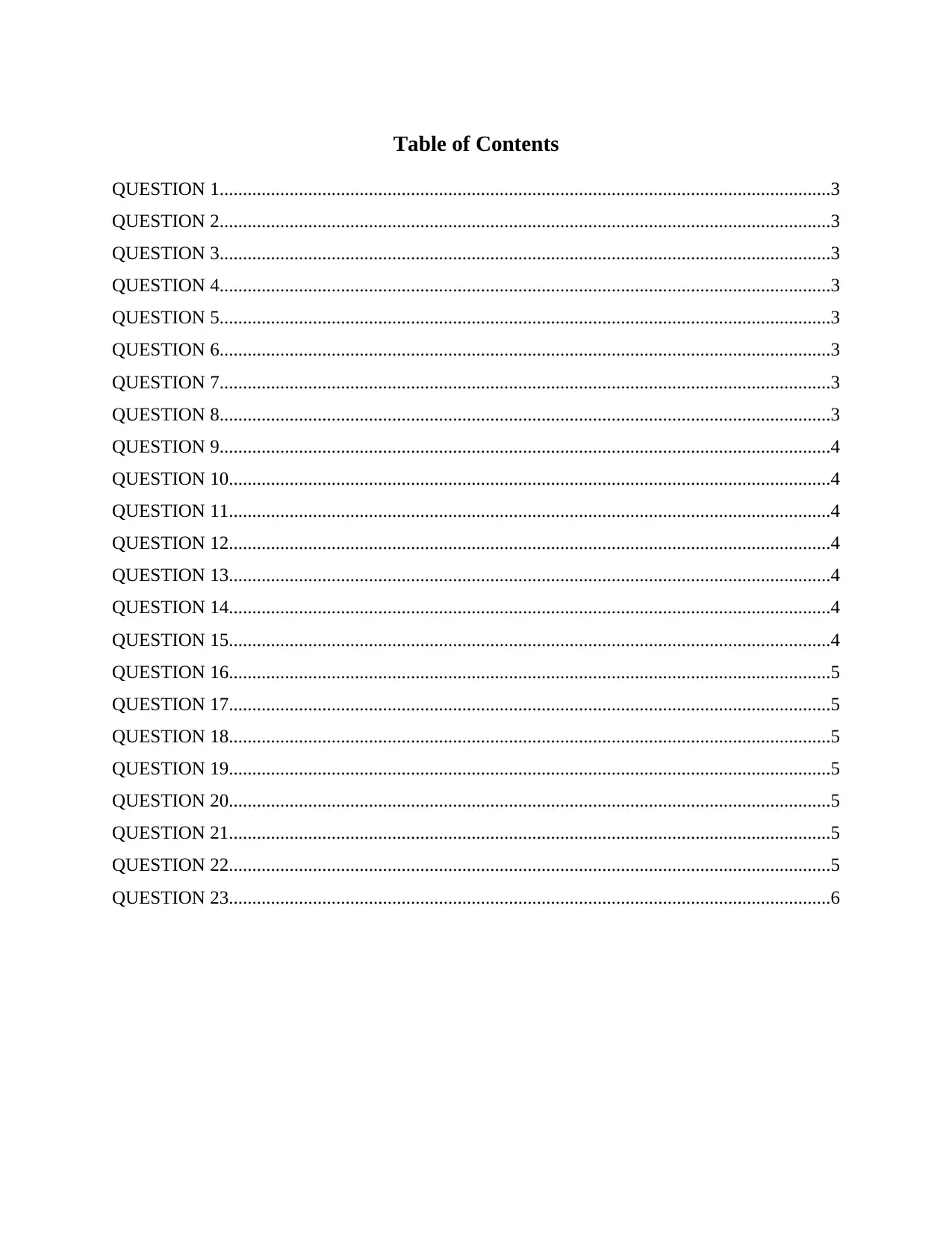
Table of Contents
QUESTION 1...................................................................................................................................3
QUESTION 2...................................................................................................................................3
QUESTION 3...................................................................................................................................3
QUESTION 4...................................................................................................................................3
QUESTION 5...................................................................................................................................3
QUESTION 6...................................................................................................................................3
QUESTION 7...................................................................................................................................3
QUESTION 8...................................................................................................................................3
QUESTION 9...................................................................................................................................4
QUESTION 10.................................................................................................................................4
QUESTION 11.................................................................................................................................4
QUESTION 12.................................................................................................................................4
QUESTION 13.................................................................................................................................4
QUESTION 14.................................................................................................................................4
QUESTION 15.................................................................................................................................4
QUESTION 16.................................................................................................................................5
QUESTION 17.................................................................................................................................5
QUESTION 18.................................................................................................................................5
QUESTION 19.................................................................................................................................5
QUESTION 20.................................................................................................................................5
QUESTION 21.................................................................................................................................5
QUESTION 22.................................................................................................................................5
QUESTION 23.................................................................................................................................6
QUESTION 1...................................................................................................................................3
QUESTION 2...................................................................................................................................3
QUESTION 3...................................................................................................................................3
QUESTION 4...................................................................................................................................3
QUESTION 5...................................................................................................................................3
QUESTION 6...................................................................................................................................3
QUESTION 7...................................................................................................................................3
QUESTION 8...................................................................................................................................3
QUESTION 9...................................................................................................................................4
QUESTION 10.................................................................................................................................4
QUESTION 11.................................................................................................................................4
QUESTION 12.................................................................................................................................4
QUESTION 13.................................................................................................................................4
QUESTION 14.................................................................................................................................4
QUESTION 15.................................................................................................................................4
QUESTION 16.................................................................................................................................5
QUESTION 17.................................................................................................................................5
QUESTION 18.................................................................................................................................5
QUESTION 19.................................................................................................................................5
QUESTION 20.................................................................................................................................5
QUESTION 21.................................................................................................................................5
QUESTION 22.................................................................................................................................5
QUESTION 23.................................................................................................................................6
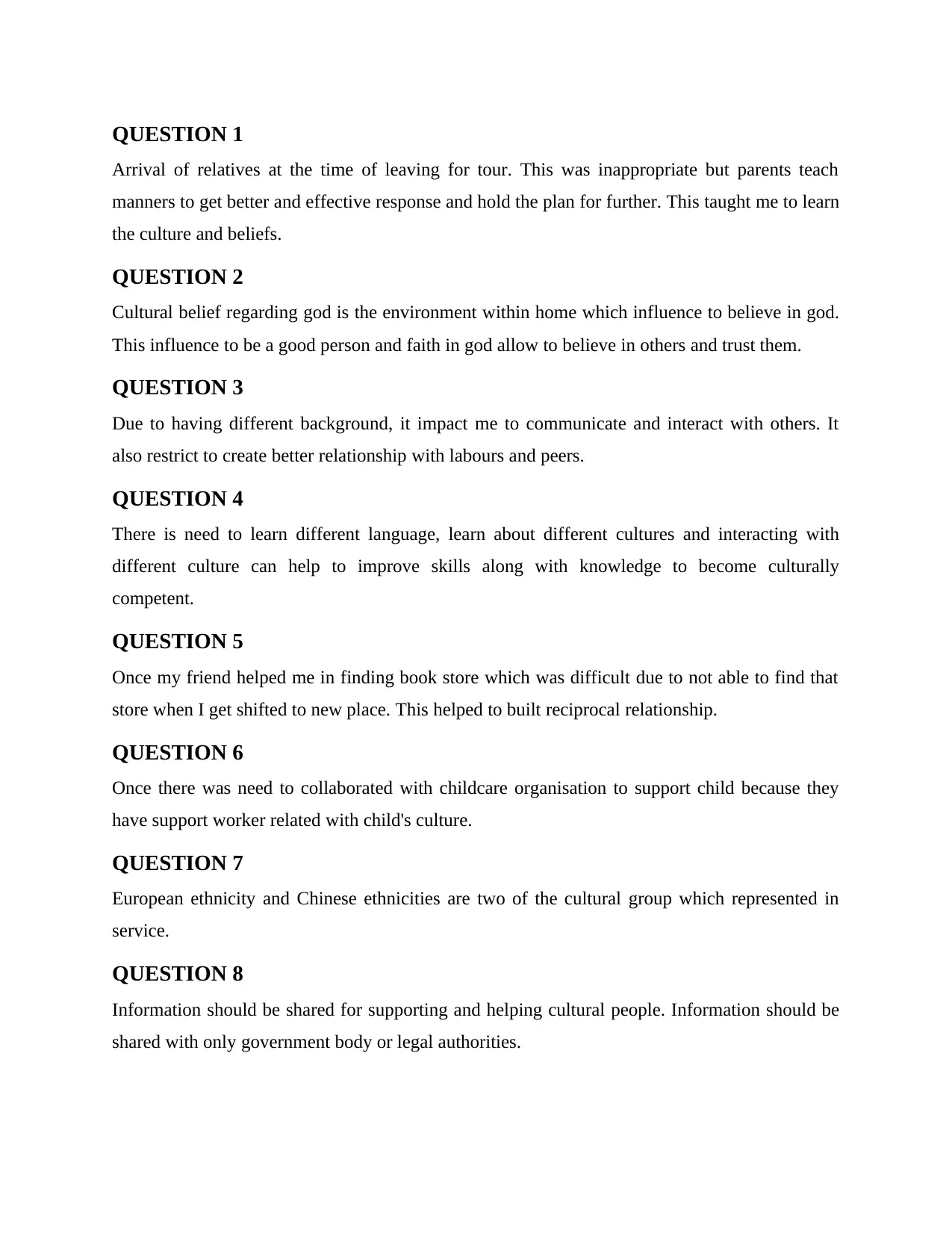
QUESTION 1
Arrival of relatives at the time of leaving for tour. This was inappropriate but parents teach
manners to get better and effective response and hold the plan for further. This taught me to learn
the culture and beliefs.
QUESTION 2
Cultural belief regarding god is the environment within home which influence to believe in god.
This influence to be a good person and faith in god allow to believe in others and trust them.
QUESTION 3
Due to having different background, it impact me to communicate and interact with others. It
also restrict to create better relationship with labours and peers.
QUESTION 4
There is need to learn different language, learn about different cultures and interacting with
different culture can help to improve skills along with knowledge to become culturally
competent.
QUESTION 5
Once my friend helped me in finding book store which was difficult due to not able to find that
store when I get shifted to new place. This helped to built reciprocal relationship.
QUESTION 6
Once there was need to collaborated with childcare organisation to support child because they
have support worker related with child's culture.
QUESTION 7
European ethnicity and Chinese ethnicities are two of the cultural group which represented in
service.
QUESTION 8
Information should be shared for supporting and helping cultural people. Information should be
shared with only government body or legal authorities.
Arrival of relatives at the time of leaving for tour. This was inappropriate but parents teach
manners to get better and effective response and hold the plan for further. This taught me to learn
the culture and beliefs.
QUESTION 2
Cultural belief regarding god is the environment within home which influence to believe in god.
This influence to be a good person and faith in god allow to believe in others and trust them.
QUESTION 3
Due to having different background, it impact me to communicate and interact with others. It
also restrict to create better relationship with labours and peers.
QUESTION 4
There is need to learn different language, learn about different cultures and interacting with
different culture can help to improve skills along with knowledge to become culturally
competent.
QUESTION 5
Once my friend helped me in finding book store which was difficult due to not able to find that
store when I get shifted to new place. This helped to built reciprocal relationship.
QUESTION 6
Once there was need to collaborated with childcare organisation to support child because they
have support worker related with child's culture.
QUESTION 7
European ethnicity and Chinese ethnicities are two of the cultural group which represented in
service.
QUESTION 8
Information should be shared for supporting and helping cultural people. Information should be
shared with only government body or legal authorities.
⊘ This is a preview!⊘
Do you want full access?
Subscribe today to unlock all pages.

Trusted by 1+ million students worldwide
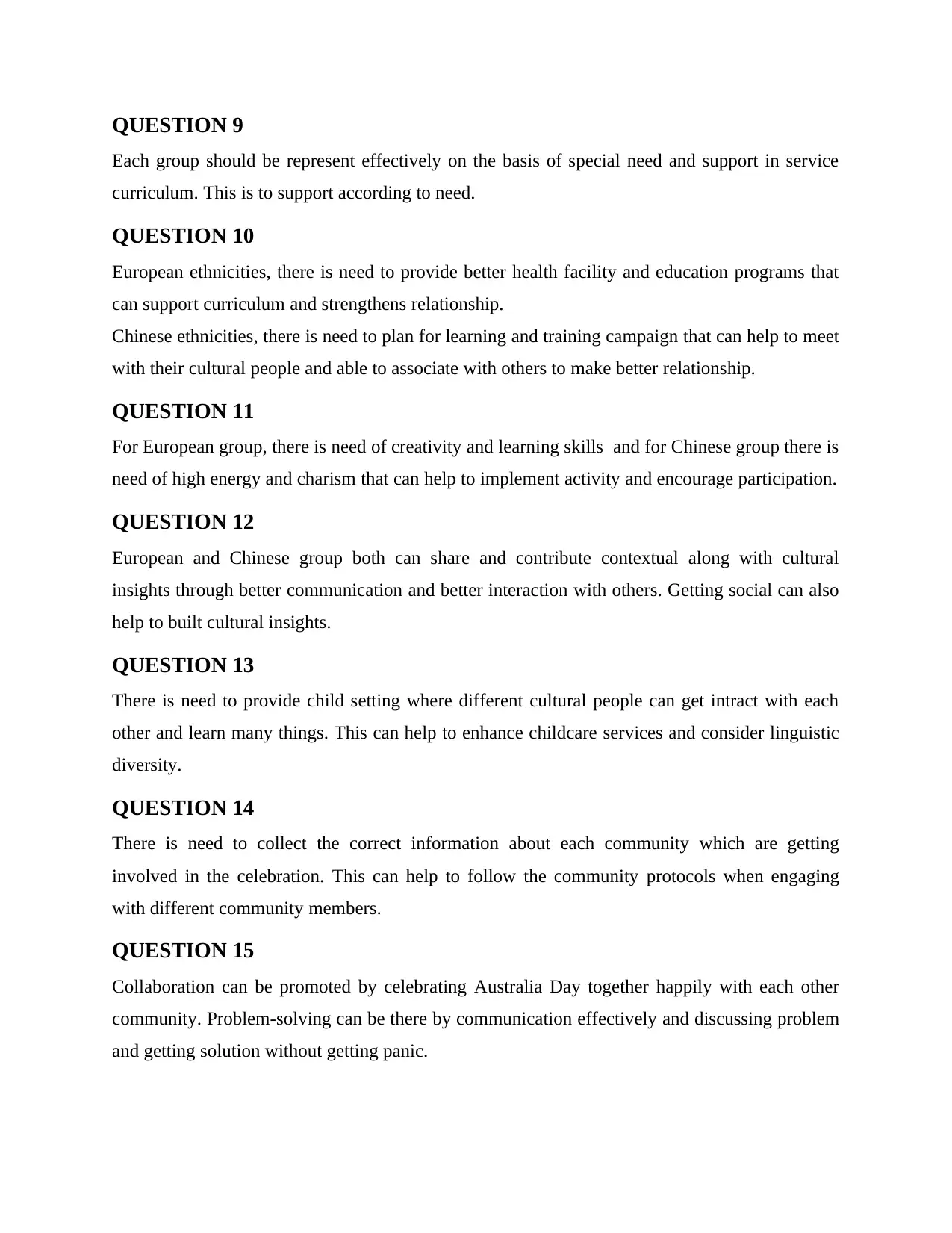
QUESTION 9
Each group should be represent effectively on the basis of special need and support in service
curriculum. This is to support according to need.
QUESTION 10
European ethnicities, there is need to provide better health facility and education programs that
can support curriculum and strengthens relationship.
Chinese ethnicities, there is need to plan for learning and training campaign that can help to meet
with their cultural people and able to associate with others to make better relationship.
QUESTION 11
For European group, there is need of creativity and learning skills and for Chinese group there is
need of high energy and charism that can help to implement activity and encourage participation.
QUESTION 12
European and Chinese group both can share and contribute contextual along with cultural
insights through better communication and better interaction with others. Getting social can also
help to built cultural insights.
QUESTION 13
There is need to provide child setting where different cultural people can get intract with each
other and learn many things. This can help to enhance childcare services and consider linguistic
diversity.
QUESTION 14
There is need to collect the correct information about each community which are getting
involved in the celebration. This can help to follow the community protocols when engaging
with different community members.
QUESTION 15
Collaboration can be promoted by celebrating Australia Day together happily with each other
community. Problem-solving can be there by communication effectively and discussing problem
and getting solution without getting panic.
Each group should be represent effectively on the basis of special need and support in service
curriculum. This is to support according to need.
QUESTION 10
European ethnicities, there is need to provide better health facility and education programs that
can support curriculum and strengthens relationship.
Chinese ethnicities, there is need to plan for learning and training campaign that can help to meet
with their cultural people and able to associate with others to make better relationship.
QUESTION 11
For European group, there is need of creativity and learning skills and for Chinese group there is
need of high energy and charism that can help to implement activity and encourage participation.
QUESTION 12
European and Chinese group both can share and contribute contextual along with cultural
insights through better communication and better interaction with others. Getting social can also
help to built cultural insights.
QUESTION 13
There is need to provide child setting where different cultural people can get intract with each
other and learn many things. This can help to enhance childcare services and consider linguistic
diversity.
QUESTION 14
There is need to collect the correct information about each community which are getting
involved in the celebration. This can help to follow the community protocols when engaging
with different community members.
QUESTION 15
Collaboration can be promoted by celebrating Australia Day together happily with each other
community. Problem-solving can be there by communication effectively and discussing problem
and getting solution without getting panic.
Paraphrase This Document
Need a fresh take? Get an instant paraphrase of this document with our AI Paraphraser
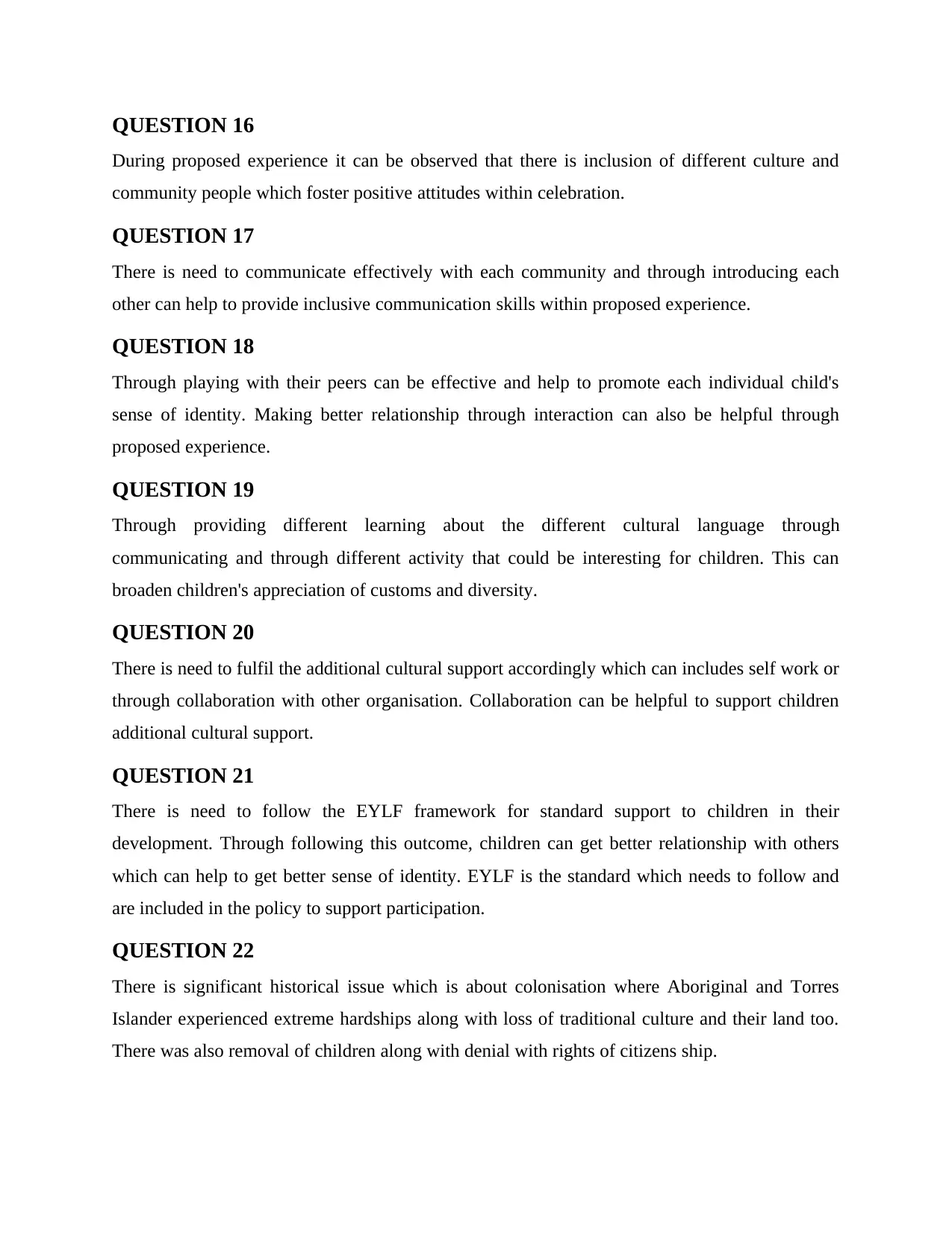
QUESTION 16
During proposed experience it can be observed that there is inclusion of different culture and
community people which foster positive attitudes within celebration.
QUESTION 17
There is need to communicate effectively with each community and through introducing each
other can help to provide inclusive communication skills within proposed experience.
QUESTION 18
Through playing with their peers can be effective and help to promote each individual child's
sense of identity. Making better relationship through interaction can also be helpful through
proposed experience.
QUESTION 19
Through providing different learning about the different cultural language through
communicating and through different activity that could be interesting for children. This can
broaden children's appreciation of customs and diversity.
QUESTION 20
There is need to fulfil the additional cultural support accordingly which can includes self work or
through collaboration with other organisation. Collaboration can be helpful to support children
additional cultural support.
QUESTION 21
There is need to follow the EYLF framework for standard support to children in their
development. Through following this outcome, children can get better relationship with others
which can help to get better sense of identity. EYLF is the standard which needs to follow and
are included in the policy to support participation.
QUESTION 22
There is significant historical issue which is about colonisation where Aboriginal and Torres
Islander experienced extreme hardships along with loss of traditional culture and their land too.
There was also removal of children along with denial with rights of citizens ship.
During proposed experience it can be observed that there is inclusion of different culture and
community people which foster positive attitudes within celebration.
QUESTION 17
There is need to communicate effectively with each community and through introducing each
other can help to provide inclusive communication skills within proposed experience.
QUESTION 18
Through playing with their peers can be effective and help to promote each individual child's
sense of identity. Making better relationship through interaction can also be helpful through
proposed experience.
QUESTION 19
Through providing different learning about the different cultural language through
communicating and through different activity that could be interesting for children. This can
broaden children's appreciation of customs and diversity.
QUESTION 20
There is need to fulfil the additional cultural support accordingly which can includes self work or
through collaboration with other organisation. Collaboration can be helpful to support children
additional cultural support.
QUESTION 21
There is need to follow the EYLF framework for standard support to children in their
development. Through following this outcome, children can get better relationship with others
which can help to get better sense of identity. EYLF is the standard which needs to follow and
are included in the policy to support participation.
QUESTION 22
There is significant historical issue which is about colonisation where Aboriginal and Torres
Islander experienced extreme hardships along with loss of traditional culture and their land too.
There was also removal of children along with denial with rights of citizens ship.
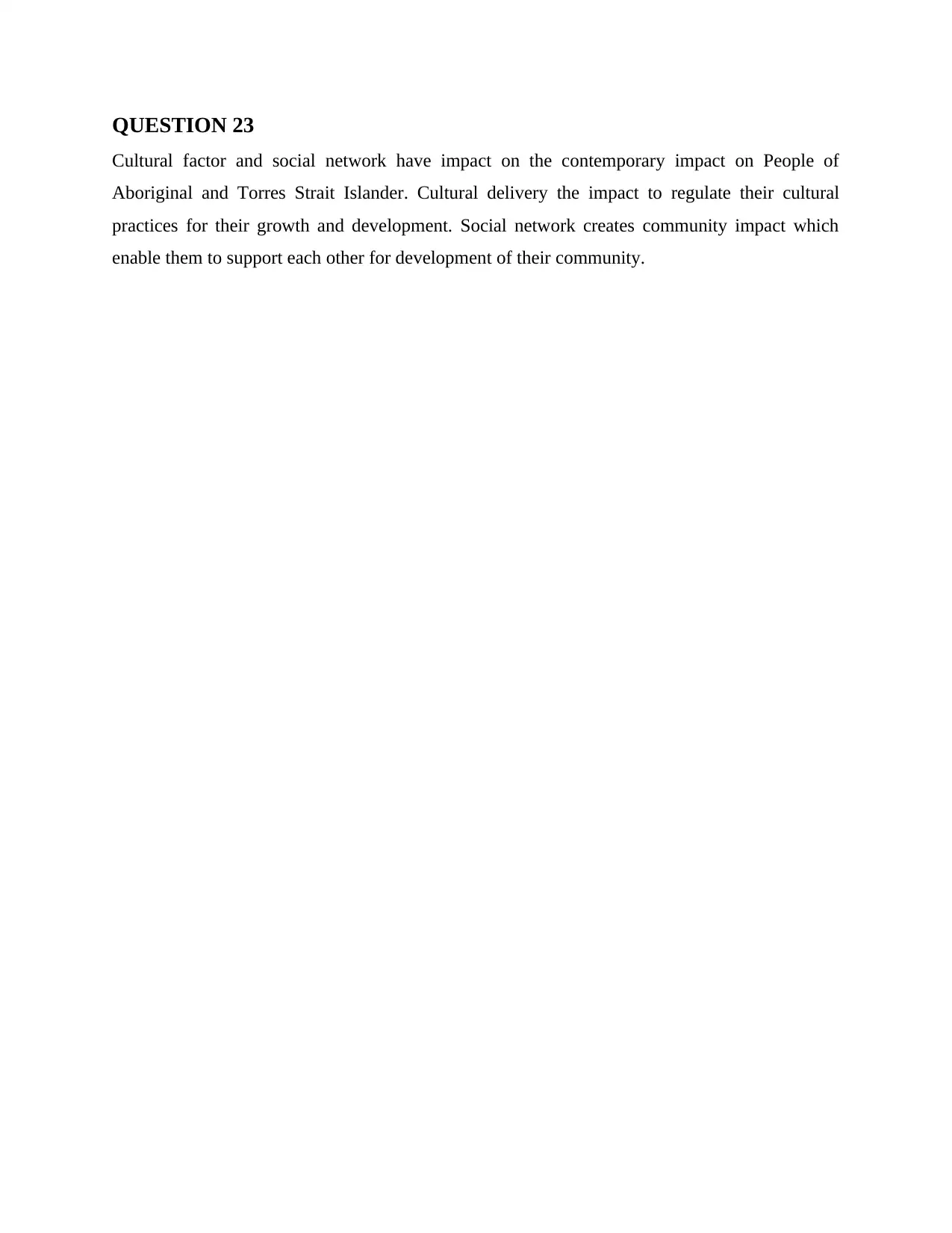
QUESTION 23
Cultural factor and social network have impact on the contemporary impact on People of
Aboriginal and Torres Strait Islander. Cultural delivery the impact to regulate their cultural
practices for their growth and development. Social network creates community impact which
enable them to support each other for development of their community.
Cultural factor and social network have impact on the contemporary impact on People of
Aboriginal and Torres Strait Islander. Cultural delivery the impact to regulate their cultural
practices for their growth and development. Social network creates community impact which
enable them to support each other for development of their community.
⊘ This is a preview!⊘
Do you want full access?
Subscribe today to unlock all pages.

Trusted by 1+ million students worldwide
1 out of 6
Related Documents
Your All-in-One AI-Powered Toolkit for Academic Success.
+13062052269
info@desklib.com
Available 24*7 on WhatsApp / Email
![[object Object]](/_next/static/media/star-bottom.7253800d.svg)
Unlock your academic potential
Copyright © 2020–2025 A2Z Services. All Rights Reserved. Developed and managed by ZUCOL.





